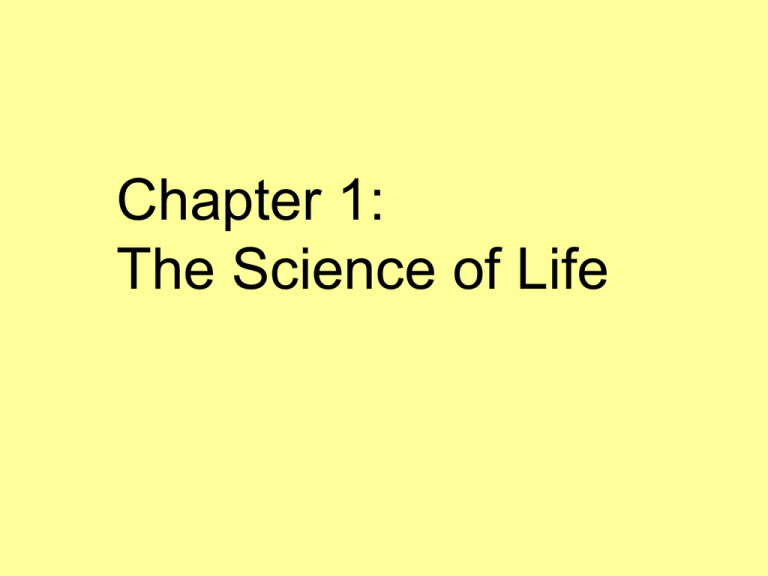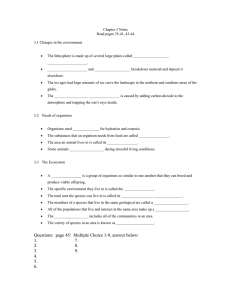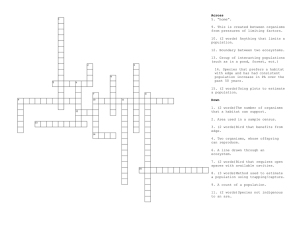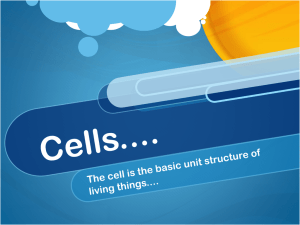Chapter 1: The Science of Life
advertisement

Chapter 1: The Science of Life Biology – The study of life Organism – A living thing; anything that can carry out life processes independently Branches of biology – •There are many subtopics within biology – a few examples we’ll hit upon this year: •Biochemistry – Study of the chemistry of life •Genetics – Study of how organisms pass traits to their offspring Evolutionary theory – Study of changes in types of organisms over time Cell biology – Study of life on the cellular level Microbiology – Study of microscopic organisms Botany – Study of plants Zoology – Study of animals Physiology – Functions, activities, and processes of organisms Ecology – Study of how organisms interact with eachother and the environment Properties of Life 1. Cellular organization Cell – a highly organized, tiny structure that in enclosed in a thin covering called a membrane A cell is the smallest unit capable of all life functions •Organisms can be unicellular or multicellular •Multicellular organisms – more than 1 cell •Cells in these organisms are considered specialized (have certain jobs) •Examples: some fungus, all plants, all animals Unicellular organisms - one cell •1 cell does all jobs for organism •Examples: bacteria, protists, and some fungus There are various levels of cellular organization –vary based on how complex the organism is In general: cells tissues organs organ systems organisms Cells are the smallest unit of life, organisms the biggest 2. Homeostasis • Maintaining a stable internal environment in order to function properly (such as body temperature, pH, blood pressure, water balance) regardless of changes in the external environment Example: sweating or shivering to maintain body temperature 3. Metabolism – the sum of all of the chemical reactions carried out in an organism • Reactions carried out to obtain energy • Organisms can obtain energy in one of two ways: heterotrophs and autotrophs •Heterotrophs are organisms that obtain nutrients from food eaten Ex: some bacteria and protists, fungus, & animals •Autotrophs are organisms that make their own food through photosynthesis Ex: plants, some protists, and some bacteria 4. Responsiveness – living organisms must respond to their external environment • Ex: plants bend toward the light, birds fluff feathers to stay warm in winter 5. Reproduction – the process by which organisms make more of their own kind from one generation to the next Prevents extinction of species Can be sexual or asexual 6. Heredity – process through which an organism passes on its own traits to its offspring during reproduction •Asexual reproduction •only 1 parent •offspring has DNA identical to parent •Sexual reproduction •2 parents •each parent contributes ½ genetic information to offspring •offspring has mixed traits from parents 7. Growth - an increase in the number of cells/ increase in the size Example – getting taller As organisms grow, they may change, or develop Development – Changes an organism undergoes to reach adult form Example – baby kid teen adult; tadpole to frog; caterpillar to butterfly Classification •Taxonomy – The practice of naming and classifying organisms •Taxa –the categories into which organisms are classified The taxa: Domain Kingdom Phylum (Division for plants) Class Order Family Genus Species Did King Phillip Come Over For Good Spaghetti??? Domain Archaea – Unicellular prokaryotes May have been first cells Live in aquatic environments that lack oxygen or are too salty, too hot, or too acidic for most other organisms – like primitive Earth(?) Domain Bacteria Unicellular prokaryotes Found almost anywhere – in soil, water, atmosphere, on and inside living organisms Domain Eukarya Cells contain membrane-bound nucleus Four Kingdoms within – Protists (Protista) Fungus (Fungi) Plants (Plantae) Animals (Animalia) Why can’t we just use common names? •Not very specific •Ex: What KIND of frog? •Misleading •Ex: Jellyfish is NOT a fish, ringworm is NOT a worm •Vary by language and geography •Ex: Puma, mountain lion, and cougar are ALL the same animal! •A robin in one country is not the same as what is named a robin in another country What was wrong with the early systems of classification? •Forgot to include bacteria, fungus and protists •Failed to show proper relationships between organisms •Too general – ex. Aristotle classified animals by where they lived (air, land, or water) Modern system of classification: Based in part on Carl Linnaeus’ system of binomial nomenclature (“two names”) Grouped according to: physical features (morphology) the ancestral relationships between species (phylogeny) •Those placed in the same genus will be most closely related, those in different kingdoms most distantly related •Ex: Those in genus Felis are more closely related to each other than organisms in the Kingdoms Plantae and Animalia are to each other. Writing scientific names: Ex: Homo sapiens or Homo sapiens Can be abbreviated H. sapiens If typed – should be italicized. If handwritten – should be underlined. First word is genus – capitalized Second word is species - lower case







